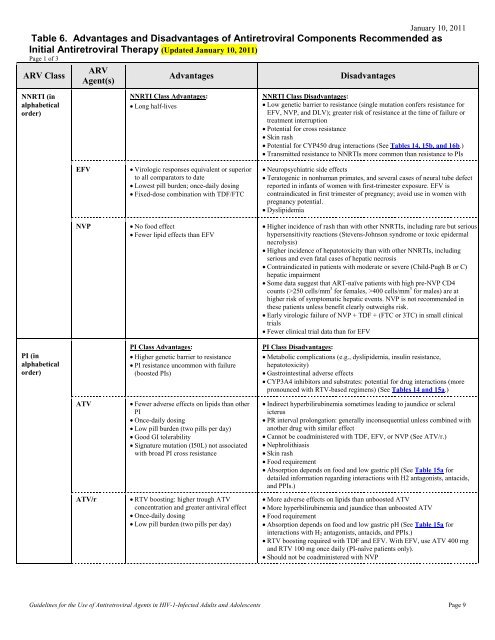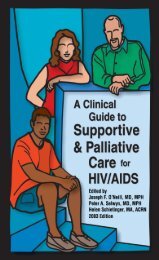Table 6. Advantages and Disadvantages of Antiretroviral ...
Table 6. Advantages and Disadvantages of Antiretroviral ...
Table 6. Advantages and Disadvantages of Antiretroviral ...
You also want an ePaper? Increase the reach of your titles
YUMPU automatically turns print PDFs into web optimized ePapers that Google loves.
January 10, 2011<br />
<strong>Table</strong> <strong>6.</strong> <strong>Advantages</strong> <strong>and</strong> <strong>Disadvantages</strong> <strong>of</strong> <strong>Antiretroviral</strong> Components Recommended as<br />
Initial <strong>Antiretroviral</strong> Therapy (Updated January 10, 2011)<br />
Page 1 <strong>of</strong> 3<br />
ARV Class<br />
ARV<br />
Agent(s)<br />
<strong>Advantages</strong><br />
<strong>Disadvantages</strong><br />
NNRTI (in<br />
alphabetical<br />
order)<br />
NNRTI Class <strong>Advantages</strong>:<br />
• Long half-lives<br />
NNRTI Class <strong>Disadvantages</strong>:<br />
• Low genetic barrier to resistance (single mutation confers resistance for<br />
EFV, NVP, <strong>and</strong> DLV); greater risk <strong>of</strong> resistance at the time <strong>of</strong> failure or<br />
treatment interruption<br />
• Potential for cross resistance<br />
• Skin rash<br />
• Potential for CYP450 drug interactions (See <strong>Table</strong>s 14, 15b, <strong>and</strong> 16b.)<br />
• Transmitted resistance to NNRTIs more common than resistance to PIs<br />
EFV<br />
NVP<br />
• Virologic responses equivalent or superior<br />
to all comparators to date<br />
• Lowest pill burden; once-daily dosing<br />
• Fixed-dose combination with TDF/FTC<br />
• No food effect<br />
• Fewer lipid effects than EFV<br />
• Neuropsychiatric side effects<br />
• Teratogenic in nonhuman primates, <strong>and</strong> several cases <strong>of</strong> neural tube defect<br />
reported in infants <strong>of</strong> women with first-trimester exposure. EFV is<br />
contraindicated in first trimester <strong>of</strong> pregnancy; avoid use in women with<br />
pregnancy potential.<br />
• Dyslipidemia<br />
• Higher incidence <strong>of</strong> rash than with other NNRTIs, including rare but serious<br />
hypersensitivity reactions (Stevens-Johnson syndrome or toxic epidermal<br />
necrolysis)<br />
• Higher incidence <strong>of</strong> hepatotoxicity than with other NNRTIs, including<br />
serious <strong>and</strong> even fatal cases <strong>of</strong> hepatic necrosis<br />
• Contraindicated in patients with moderate or severe (Child-Pugh B or C)<br />
hepatic impairment<br />
• Some data suggest that ART-naïve patients with high pre-NVP CD4<br />
counts (>250 cells/mm 3 for females, >400 cells/mm 3 for males) are at<br />
higher risk <strong>of</strong> symptomatic hepatic events. NVP is not recommended in<br />
these patients unless benefit clearly outweighs risk.<br />
• Early virologic failure <strong>of</strong> NVP + TDF + (FTC or 3TC) in small clinical<br />
trials<br />
• Fewer clinical trial data than for EFV<br />
PI (in<br />
alphabetical<br />
order)<br />
PI Class <strong>Advantages</strong>:<br />
• Higher genetic barrier to resistance<br />
• PI resistance uncommon with failure<br />
(boosted PIs)<br />
PI Class <strong>Disadvantages</strong>:<br />
• Metabolic complications (e.g., dyslipidemia, insulin resistance,<br />
hepatotoxicity)<br />
• Gastrointestinal adverse effects<br />
• CYP3A4 inhibitors <strong>and</strong> substrates: potential for drug interactions (more<br />
pronounced with RTV-based regimens) (See <strong>Table</strong>s 14 <strong>and</strong> 15a.)<br />
ATV<br />
ATV/r<br />
• Fewer adverse effects on lipids than other<br />
PI<br />
• Once-daily dosing<br />
• Low pill burden (two pills per day)<br />
• Good GI tolerability<br />
• Signature mutation (I50L) not associated<br />
with broad PI cross resistance<br />
• RTV boosting: higher trough ATV<br />
concentration <strong>and</strong> greater antiviral effect<br />
• Once-daily dosing<br />
• Low pill burden (two pills per day)<br />
• Indirect hyperbilirubinemia sometimes leading to jaundice or scleral<br />
icterus<br />
• PR interval prolongation: generally inconsequential unless combined with<br />
another drug with similar effect<br />
• Cannot be coadministered with TDF, EFV, or NVP (See ATV/r.)<br />
• Nephrolithiasis<br />
• Skin rash<br />
• Food requirement<br />
• Absorption depends on food <strong>and</strong> low gastric pH (See <strong>Table</strong> 15a for<br />
detailed information regarding interactions with H2 antagonists, antacids,<br />
<strong>and</strong> PPIs.)<br />
• More adverse effects on lipids than unboosted ATV<br />
• More hyperbilirubinemia <strong>and</strong> jaundice than unboosted ATV<br />
• Food requirement<br />
• Absorption depends on food <strong>and</strong> low gastric pH (See <strong>Table</strong> 15a for<br />
interactions with H 2 antagonists, antacids, <strong>and</strong> PPIs.)<br />
• RTV boosting required with TDF <strong>and</strong> EFV. With EFV, use ATV 400 mg<br />
<strong>and</strong> RTV 100 mg once daily (PI-naïve patients only).<br />
• Should not be coadministered with NVP<br />
Guidelines for the Use <strong>of</strong> <strong>Antiretroviral</strong> Agents in HIV-1-Infected Adults <strong>and</strong> Adolescents Page 9
<strong>Table</strong> <strong>6.</strong> <strong>Advantages</strong> <strong>and</strong> <strong>Disadvantages</strong> <strong>of</strong> <strong>Antiretroviral</strong> Components Recommended as Initial <strong>Antiretroviral</strong> Therapy<br />
Page 2 <strong>of</strong> 3<br />
January 10, 2011<br />
ARV Class<br />
ARV<br />
Agent(s)<br />
<strong>Advantages</strong><br />
<strong>Disadvantages</strong><br />
DRV/r • Once-daily dosing • Skin rash<br />
• Food requirement<br />
FPV • No food effect • Skin rash<br />
• Potential for PI resistance with failure, including emergence <strong>of</strong> mutations<br />
that can cause DRV cross resistance<br />
FPV/r<br />
LPV/r<br />
SQV/r<br />
• Twice-daily dosing resulted in efficacy<br />
comparable to LPV/r<br />
• RTV boosting: higher trough APV<br />
concentration <strong>and</strong> greater antiviral effect<br />
• Once-daily dosing possible with RTV 100<br />
mg or 200 mg daily<br />
• No food effect<br />
• C<strong>of</strong>ormulated<br />
• No food requirement<br />
• Recommended PI in pregnant women<br />
(twice daily only)<br />
• Greater CD4 count increase than with<br />
EFV-based regimens<br />
• Efficacy similar to LPV/r with less<br />
hyperlipidemia<br />
• Skin rash<br />
• Hyperlipidemia<br />
• Once-daily dosing results in lower APV concentrations than twice-daily<br />
dosing<br />
• For FPV 1,400 mg + RTV 200 mg: requires 200 mg <strong>of</strong> RTV <strong>and</strong> no<br />
c<strong>of</strong>ormulation<br />
• Fewer data on FPV 1,400 mg + RTV 100 mg dose than on DRV/r <strong>and</strong><br />
ATV/r<br />
• Requires 200 mg per day <strong>of</strong> RTV<br />
• Lower drug exposure in pregnant women—may need dose increase in<br />
third trimester<br />
• Once-daily dosing not recommended in pregnant women<br />
• Once-daily dosing: lower trough concentration than twice-daily dosing<br />
• Possible higher risk <strong>of</strong> MI associated with cumulative use <strong>of</strong> LPV/r<br />
• PR <strong>and</strong> QT interval prolongation have been reported. Use with caution in<br />
patients at risk <strong>of</strong> cardiac conduction abnormalities or receiving other<br />
drugs with similar effect.<br />
• Highest pill burden among available PI regimens (6 pills per day)<br />
• Requires 200 mg <strong>of</strong> RTV<br />
• Food requirement<br />
• PR <strong>and</strong>/or QT interval prolongations in a healthy volunteer study<br />
• Pretreatment ECG recommended<br />
• SQV/r is not recommended for patients with any <strong>of</strong> the following<br />
conditions: (1) congenital or acquired QT prolongation; (2) pretreatment<br />
ECG >450 msec; (3) on concomitant therapy with other drugs that prolong<br />
QT interval; (4) complete AV block without implanted pacemakers; (5)<br />
risk <strong>of</strong> complete AV block.<br />
INSTI RAL • Virologic response noninferior to EFV<br />
• Fewer drug-related adverse events <strong>and</strong><br />
lipid changes than EFV<br />
• No food effect<br />
• Fewer drug-drug interactions than PI- or<br />
NNRTI-based regimens<br />
• Less long-term experience in ART-naïve patients than with boosted PI- or<br />
NNRTI-based regimens<br />
• Twice-daily dosing<br />
• Lower genetic barrier to resistance than with boosted PI-based regimens<br />
• No data with NRTIs other than TDF/FTC in ART-naïve patients<br />
CCR5<br />
Antagonist<br />
MVC<br />
• Virologic response noninferior to EFV in<br />
post-hoc analysis <strong>of</strong> MERIT study (See<br />
text.)<br />
• Fewer adverse effects than EFV<br />
• Requires viral tropism testing prior to initiation <strong>of</strong> therapy with additional<br />
cost <strong>and</strong> possible delay in initiation <strong>of</strong> therapy<br />
• More MVC-treated than EFV-treated patients discontinued therapy due to<br />
lack <strong>of</strong> efficacy in MERIT study<br />
• Less long-term experience in ART-naïve patients than with boosted PI- or<br />
NNRTI-based regimens<br />
• Limited experience with 2-NRTI other than ZDV/3TC<br />
• Twice-daily dosing<br />
• CYP 3A4 substrate, dosing depends on presence or absence <strong>of</strong> concomitant<br />
CYP3A4 inducer(s) or inhibitor(s)<br />
Dual NRTIs<br />
Dual-NRTI Class Advantage:<br />
Established backbone <strong>of</strong> combination ART<br />
Dual-NRTI Class Disadvantage:<br />
Rare but serious cases <strong>of</strong> lactic acidosis with hepatic steatosis reported with<br />
d4T, ddI, <strong>and</strong> ZDV<br />
Guidelines for the Use <strong>of</strong> <strong>Antiretroviral</strong> Agents in HIV-1-Infected Adults <strong>and</strong> Adolescents Page 10
<strong>Table</strong> <strong>6.</strong> <strong>Advantages</strong> <strong>and</strong> <strong>Disadvantages</strong> <strong>of</strong> <strong>Antiretroviral</strong> Components Recommended as Initial <strong>Antiretroviral</strong> Therapy<br />
Page 3 <strong>of</strong> 3<br />
Dual-NRTI<br />
pairs (in<br />
alphabetical<br />
order)<br />
ABC/3TC<br />
ddI + (3TC or<br />
FTC)<br />
TDF/FTC or<br />
TDF + 3TC<br />
ZDV/3TC<br />
• Virologic response noninferior to<br />
ZDV/3TC<br />
• Better CD4 count response than with<br />
ZDV/3TC<br />
• Once-daily dosing<br />
• C<strong>of</strong>ormulation<br />
• No food effect<br />
• No cumulative TAM-mediated resistance<br />
• Once-daily dosing<br />
• No cumulative TAM-mediated resistance<br />
• Better virologic responses than with<br />
ZDV/3TC<br />
• Better virologic responses than with<br />
ABC/3TC in patients with baseline HIV<br />
RNA >100,000 copies/mL in ACTG 5202<br />
study; however, this was not seen in the<br />
HEAT study.<br />
• Active against HBV; recommended dual-<br />
NRTI for HBV/HIV coinfection<br />
• Once-daily dosing<br />
• No food effect<br />
• C<strong>of</strong>ormulated (TDF/FTC) <strong>and</strong><br />
(EFV/TDF/FTC)<br />
• No cumulative TAM-mediated resistance<br />
• C<strong>of</strong>ormulated (ZDV/3TC <strong>and</strong><br />
ZDV/3TC/ABC)<br />
• No food effect (although better tolerated<br />
with food)<br />
• Preferred 2 NRTI in pregnant women<br />
January 10, 2011<br />
• Potential for ABC HSR in patients with HLA-B*5701<br />
• Potential for increased cardiovascular events, especially in patients with<br />
cardiovascular risk factors<br />
• Inferior virologic responses when compared with TDF/FTC in patients<br />
with baseline HIV RNA >100,000 copies/mL in ACTG 5202 study;<br />
however, this was not seen in the HEAT study.<br />
• Peripheral neuropathy, pancreatitis<br />
• Reports <strong>of</strong> noncirrhotic portal hypertension<br />
• Food effect; must be taken on an empty stomach<br />
• Requires dosing separation from some PIs<br />
• Increase in toxicities when used with ribavirin, TDF, d4T, or hydroxyurea<br />
• Preliminary data showed inferior virologic responses <strong>of</strong> ATV/ddI/FTC<br />
when compared with EFV/ZDV/3TC or EFV/TDF/FTC. Combination <strong>of</strong><br />
ATV/ddI/FTC should be avoided.<br />
• Potential for renal impairment, including rare reports <strong>of</strong> Fanconi syndrome<br />
<strong>and</strong> acute renal insufficiency<br />
• Early virologic failure <strong>of</strong> NVP + TDF + (FTC or 3TC) in small clinical<br />
trials<br />
• Potential for decrease in bone mineral density<br />
• Bone marrow suppression, especially anemia <strong>and</strong> neutropenia<br />
• GI intolerance, headache<br />
• Mitochondrial toxicity, including lipoatrophy, lactic acidosis, hepatic<br />
steatosis<br />
• Inferior to TDF/FTC in combination with EFV<br />
• Diminished CD4 T-cell responses compared with ABC/3TC<br />
Acronyms: 3TC = lamivudine, ABC = abacavir, ART = antiretroviral therapy, ARV = antiretroviral, ATV = atazanavir, ATV/r = atazanavir/ritonavir,<br />
AV = atrioventricular, CYP = cytochrome P, ddI = didanosine, DLV = delavirdine, DRV/r = darunavir/ritonavir, ECG = electrocardiogram, EFV = efavirenz,<br />
FPV = fosamprenavir, FPV/r = fosamprenavir/ ritonavir, FTC = emtricitabine, GI = gastrointestinal, HBV = hepatitis B virus, HSR = hypersensitivity reaction,<br />
INSTI = integrase str<strong>and</strong> transfer inhibitor, LPV/r = lopinavir/ritonavir, MI = myocardial infarction, msec = milliseconds, MVC = maraviroc,<br />
NNRTI = non-nucleoside reverse transcriptase inhibitor, NRTI = nucleoside reverse transcriptase inhibitor, NVP = nevirapine, PI = protease inhibitor,<br />
PPI = proton pump inhibitor, SQV/r = saquinavir/ritonavir, TAM = thymidine analogue mutation, TDF = ten<strong>of</strong>ovir, ZDV = zidovudine<br />
Guidelines for the Use <strong>of</strong> <strong>Antiretroviral</strong> Agents in HIV-1-Infected Adults <strong>and</strong> Adolescents Page 11
















